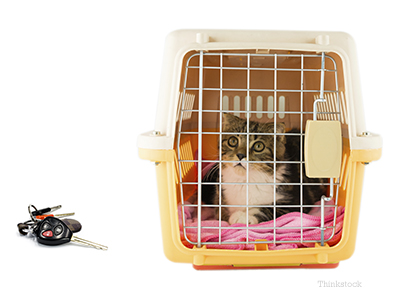
How many cats do you know that love to ride in a car? The fact is, cats aren’t dogs, and most cats are unlikely to ever enjoy a car ride the way some of their canine counterparts do. The goal of my blog isn’t to convert your cat into an easy rider, but since cats have to ride in cars sometimes, my goal is to describe a few simple actions you can take to make the car ride less stressful for you and your cat.
Unfortunately, cats and car rides are inevitable. While cats don’t have to commute to work every day, according to the AAHA-AVMA Feline Preventive Healthcare Guidelines, cats should be taken to the veterinarian at least once a year. Anyone who has ever ridden in a car with a meowing, stressed-out feline knows how unpleasant the car ride can be for everyone involved. The solution involves understanding the underlying problem. For most cats, the only time they are ever in a car is when they are placed in a carrier and taken to the veterinarian where they are examined from head to tail by a total stranger, have their temperature taken rectally, and may even get shots! So can you blame them if they don’t like going in a car? It’s not like getting into a car ever means a trip to Disneyland to see the world’s biggest rodent. Nope! For most cats, the car means one thing and one thing only — a trip to the doctor to get poked and prodded.
So what can you do to make the car ride more enjoyable for everyone involved? Here are a few tips:
Prepare your cat for the car ride
Make sure your cat has current identification tags before he leaves the house. I am a firm believer in microchips and ID tags for all animals, even indoor-only cats. As a shelter vet, I have seen way too many lost cats and heard too many stories about cats getting lost while going to the vet. Some cats will try to dart out the door the moment they realize they are going to the veterinarian. Others try to escape from their carrier if the carrier door is not properly secured. So before you go, make sure your cat has a collar, ID tags, and ideally a microchip.
Your cat should be secured in the car
Keep all traveling cats in a carrier. This is for your own safety as well as your cat’s safety. It is not safe to have your cat roaming freely in your vehicle while you are driving. Your cat could become frightened and dart under the brake pedal or accelerator, possibly causing an accident. In addition, having a cat jumping around the vehicle is a dangerous distraction. To be safe, always keep your cat in a secure carrier.
Get your cat acclimated to the carrier before the trip
Can you imagine being awoken from your afternoon nap by someone grabbing you, and then cramming you into an unfamiliar box while you are kicking and screaming? Well that might describe how our cats feel when we put them in a carrier to take them to the vet. It’s easy to see why cats might hate going in a carrier. So instead of sneaking up on them and forcing them into the carrier, we should strive to make the carrier a more positive experience. Bring the carrier out a few days ahead of time so that your cat can become accustomed to it. Leave the door of the crate open so he can explore as he pleases. Spray the interior of your cat carrier with a synthetic, feline pheromone-product. These products have been shown to decrease stress in cats. You can also put some of your cat’s favorite treats or catnip inside the carrier so that your cat associates the carrier with a positive experience. Avoid treats if your cats is being fasted for anesthesia or special blood tests. Make the carrier more inviting by placing a cozy blanket from home and your cat’s favorite toys inside. Putting familiar objects inside will make the carrier less foreign and more inviting.
Take short car rides with your cat first
Practice makes perfect. Start by sitting in the car with your cat in his carrier for just a few minutes, then go back inside and reward your cat with a treat. Then go on short trips, like going around the block, in order to acclimate your cat to being in a carrier and in a car. Remember to always reward him after the drive, so that he associates car rides with positive experiences.
Know when to get help for your cat
If you've tried all of these things and your cat still goes crazy whenever he goes for a ride in the car, get help! Ask your veterinarian if a sedative might be helpful for your cat before car rides. To avoid car rides altogether, ask your veterinarian if he makes house calls.
How about reducing cat stress during veterinary visits>>
If you have any questions or concerns, you should always visit or call your veterinarian -- they are your best resource to ensure the health and well-being of your pets.
